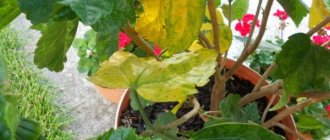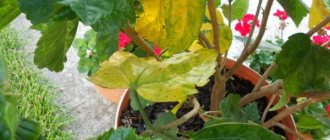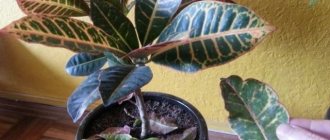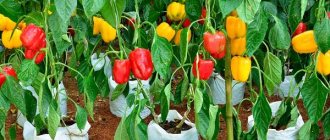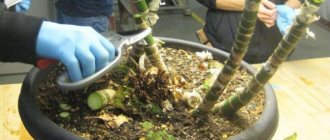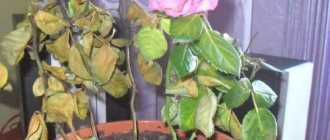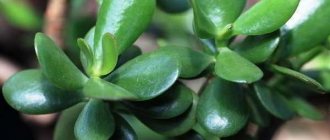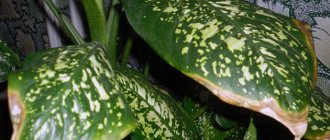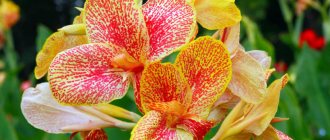Hibiscus buds may fall off due to lack of nutrition. For abundant flowering of Hibiscus (Chinese rose), fertilizing, good lighting and timely watering are very important. Another important reason for dropping buds is moving the plant to another place. The buds will fall off if the plant is exposed to drafts, standing in a cold place or watered with cold water, or if it is infested with insects.
Causes of leaf curling
A problem with the appearance and health of a flower may not appear immediately; you can buy an already diseased flower in a store.
But if you have had your hibiscus for a long time, and the leaves begin to dry out and curl, then, most likely, a mistake was made in the care. Causes of leaf disease:
- pollution;
- lack of moisture or excessive watering;
- strong sun rays;
- drafts and temperature changes;
- bad, too heavy water for irrigation;
- diseases and pests:
- problems with feeding - shortage or excess;
- need for replanting.
A flower can be diagnosed based on accompanying signs: look at what other problems hibiscus has. Leaves too yellow - check soil conditions and temperature. Curling the leaves inward will tell gardeners about low air humidity. Yellowing tops indicate the need for calcium-based fertilizers. But the rapid fall of buds can begin for a number of reasons; you will have to reconsider all care for hibiscus.
When does the Chinese rose bloom and how long does this period last?
How often do the buds open and how long do they bloom? If comfortable conditions are maintained, hibiscus blooms from July to September. Sometimes you can achieve conditions under which the rose will bloom all year round, but this is difficult to do at home. But 3 or 4 months of flowering is quite within the power of any gardener.
Hibiscus develops and grows very quickly. A young plant may bloom in the first year of planting. The flowers of the Chinese rose are very bright and showy, but are not durable. Usually this period lasts a day or two.
Systematic implementation of the rules will give the Chinese rose vigorous flowering, and the gardener will have the opportunity to admire the beautiful plant.
Previous
Diseases Why do anthurium leaves turn yellow and dry? Tips for saving the plant Next Diseases What to do if brown and yellow spots appear on the leaves of the anthurium? Causes of the problem
How to save a flower
Usually, if errors in care are eliminated, hibiscus will delight you for a long time with abundant and long-lasting flowering. But what to do with fallen buds and how to restore the flower? If the buds fall off massively, it is necessary to prune the entire plant. Dried leaves and flowers should be removed, and each shoot should be shortened by 10 cm - this procedure stimulates the tree to lay new buds and promotes rapid flowering.
If hibiscus is affected by pests, then thorough disinfection with insecticides is necessary. If aphids are infested, the flower must be washed with running water or soapy water, and then treated with a special preparation. When the roots rot, the plant is removed from the pot, all damaged roots are cut off, and the cut areas are disinfected with a solution of potassium permanganate or sprinkled with charcoal. In this form, the hibiscus is transplanted into a new pot with a completely renewed substrate.
podokonnik.temadnya.com
Read more about plant care:
Caring for garden hibiscus Why hibiscus does not bloom at home How hibiscus reproduces at home Yellow hibiscus Garden hibiscus herbaceous Hibiscus on a trunk Indoor hibiscus How to prune a Chinese rose
Categories Hibiscus Post navigation
Leave a Comment
Comment
This site uses Akismet to reduce spam. Find out how your comment data is processed.
Hibiscus pests: description and photo
Aphid
A small insect that settles on the leaves, shoots and buds of a plant. It multiplies quickly and thus covers the entire surface of the plant, creating a sticky coating on it and destroying young leaves. To get rid of aphids at an early stage, you can use a soap solution. They wash the infected areas of the flower with it. At a later stage, the plant is treated with insecticides.
Shields
After their appearance, brown tubercles form on the plant.
To get rid of them, the plant is sprayed with insecticides.
This must be done as soon as possible after detecting the pest, otherwise the plant may die.
Chervets
If waxy white discharge appears on the plant on the cuttings and leaf axils, then it has been attacked by a mealybug.
To get rid of it, the leaves are treated with mineral oils. This must be done in the shade.
Gallica
Small midges that lead to yellowing and drying of leaves and buds. The eggs of this midge are stored inside the buds, from which worms emerge. They are the ones who eat the buds, which eventually fall off.
To remove this pest, you need to treat the soil with any remedy for soil pests and collect the affected buds before they fall.
Whitefly
Leads to yellowing of leaves and covers them with sticky secretions.
Insects or their yellow larvae settle under the leaf. You can see pests without a magnifying glass.
For treatment, treat the plant with an insecticide and apply potassium soap.
Hibiscus leaves contain sugar. #10 YezhYtsa
Sent
Thank you for such attention to my problem! Of course, I understand that pruning is not worth doing now) It’s just that this question comes up to me from time to time, but my hand doesn’t)) The problem is that it’s very difficult to process all the leaves by hand - I can’t get it, and it just takes a lot of time ((Hibiscus blooms almost all spring and early summer, during the winter it also periodically throws out buds. It grows very quickly, especially in the spring the new shoots are sooo strong! The leaves are large, like burdocks
This spring, the hand again did not rise to trim at least those shoots that were blocking the passage - each had a bud! During the heating season and summer heat, the leaves turn yellow and fall off. But very moderately, not leaf fall. Spraying and a little more abundant watering helps. I’m afraid to over-water it because I don’t know what kind of soil is in the flowerbed (most likely ordinary garden soil), whether there is drainage... The soil has not changed, most likely since the plant was planted, and to be honest, I have little idea how this can be done. Periodically I loosen the top layer - otherwise the earth becomes very heavy and tight. Our Spartan grows near the south-west window; in the summer there is enough light. In winter, we do not organize any special additional lighting; we simply turn on the lights in the room when darkness falls. It burns for hours until 12 at night... can this be considered additional lighting? :) To my shame, I don’t pamper it with feeding... the last time in the spring I stuck long-lasting fertilizer sticks into the ground. The instructions said that this was enough for several months... well, somehow, only after reading articles on the Internet, I began to realize that it would be a good idea to feed the pets. In general, I read flower articles with horror... I did everything wrong!!!
Main causes and photos of the problem
Leaf deformation can be caused by several disorders at once. The most common ones include the presence of pests or diseases, but improper care of indoor plants also plays an important role.
Before starting treatment, it is necessary to find out exactly what caused the curling of the leaves, because each of the existing causes requires an individual approach.
Below you will see what a plant with curled leaves looks like:
Pests
The Chinese rose is quite resistant to a variety of pests, but the plant cannot always resist damage from spider mites or aphids. You need to look very carefully at the bottom of the sheets.
- Aphids and mites live in small colonies, so it is impossible not to notice them.
- The spider mite lives up to its name because it entwines damaged areas with a slightly noticeable web. If the curling of hibiscus leaves is caused by these pests, then it is necessary to spray the flower with a soap solution. This procedure should be repeated several times.
- If the leaves quickly curl and fall off, this indicates the presence of scale insects. Scale insects are cleaned with a regular brush or rag soaked in an alcohol solution. The alcohol solution can be replaced with soap.
Read about common diseases of hibiscus leaves here.
Our experts have also prepared articles about the following problems with hibiscus:
- What to do if the roots, stem or tips of leaves dry out and why did the problems arise?
- Why can it shed its unopened buds, how to save it?
- Why do the leaves turn yellow and fall off?
Infectious chlorosis
Often the amount of chlorophyll in Chinese rose leaves decreases, so they begin to curl. A disease such as infectious chlorosis is mainly transmitted by pests. The most common carriers are ticks, aphids and thrips. First of all, it is necessary to get rid of unwanted pests, and then water the plant with a solution of iron chelate and iron sulfate.
Priming
Hibiscus needs soil that is well permeable to air and moisture. Purchased peat-based soils are not entirely suitable for successfully growing such a plant. In this case, the leaves may begin to curl and the plant may die as a result. It is necessary to add leaf humus, which makes the soil moisture-absorbing. Adding sand or turf soil also has a great effect on the soil.
Fertilizers
In order for the Chinese rose to grow and bloom normally, it needs a lot of copper, iron, magnesium and potassium. If the plant's leaves begin to curl, this may indicate a lack of microelements. It is necessary to fertilize the soil with special substances as soon as possible.
Fertilizer for the growth of hibiscus, which is sold in any flower shop, is quite suitable. To ensure that the problem no longer makes itself felt, you need to feed the plant once a month.
Watering
If the flower is constantly located in a room with sufficiently dry air, this will certainly provoke rapid curling of the leaves. It is not recommended to allow low humidity levels in the room. You can place a tray with wet sand near the potter.
As soon as the sun's rays hit it, the moisture will begin to evaporate, which will have a positive effect on the growth of hibiscus. It is worth noting that to increase air humidity, you need to use only filtered water. It is also recommended to spray the leaves of this plant once every few weeks, but only very carefully.
Lighting
The main enemies of the Chinese rose are direct sunlight. The plant loves light very much, but from such rays it can get burns on the leaves, especially if the flower stood in the shade most of the time and then came into the sun.
Many gardeners recommend paying special attention to lighting, because not only the problem of leaf curling, but also the general condition of the plant depends on it. It is necessary to place the hibiscus in a place where there is a lot of light, but not too hot
In this case, you should water the plant as often as possible and ventilate the room.
Temperature
Inadequately keeping hibiscus in a cold room will cause the leaves to curl. Optimal temperatures should not be below 18-21 ºC. Hypothermia causes a draft, so you need to choose the right place where the plant will stand.
Chinese rose leaves curling is of course a serious problem, but it can be dealt with quite easily if you know the true cause of its occurrence. By taking the right treatment measures, you can return the plant to its former beauty and health without any problems. The hibiscus will then delight the owner for a very long time with its lush crown and beautiful flowers.
Reasons for Dropping Hibiscus Flowers
There are not many reasons for a plant to shed buds. The main ones are:
- non-compliance with rose care rules;
- lack of proper fertilization of the plant;
- damage to shrubs by insect pests;
- unfavorable place for growing.
Fertilizers include AVA, a complex fertilizer. This fertilizer does not contain nitrogen. It is good because you can add it to the ground when replanting, and then not think about fertilizing. Otherwise, hibiscus need to be fed every week.
Hibiscus responds to the angle of incidence of sunlight. When rearranged or rotated, the plant shows its character - it drops its buds. This doesn't mean it shouldn't be touched. You can take it to the bath and wash the leaves. But then return it to its previous position. Make a light mark on the pot, this will help you place the flower correctly.
Maybe the plant is standing in a cold draft. Or the water for irrigation is too cold. Or the newly purchased plant was transported under unsuitable conditions. Or the plant was replanted when the buds had already formed.
Or the difference between day and night temperatures is too great. Keep the plant ready to bloom in a very mild climate at 18 0C and air humidity not lower than 60%. Water more often and reduce the concentration of fertilizers.
Once the buds appear on the plant, do not move it, even for watering.
The room temperature may be too high or the air too dry. He may not have enough water.
Never spray flowering plants, as even small drops of water have a bad effect on the petals. Spots appear on them and they quickly fall off. Possible pests: spider mites, scale insects.
Then you will have to treat with drugs against pests: actara, etc. and so on.
Hibiscus is a very capricious plant and reacts to any change by dropping buds.
Poor drainage and incorrect soil composition lead to the fact that hibiscus leaves fade and turn yellow at the edge or along the entire leaf blade, and the buds fall off.
You can help the plant by transplanting it into a new pot with balanced soil composition and well-organized drainage.
Leaf diseases
Separately, I would like to dwell on the problems and symptoms that arise when the vital functions and development of a flower are disrupted. Leaf diseases in most cases are caused by chlorosis - a decrease in the production of chlorophyll in the green part of the plant. Below are the main symptoms of trouble in the state of hibiscus, as well as their possible causes:
- Yellowing of leaves – pest infestation, plant root diseases, leaf chlorosis, poor indoor air humidification.
- Falling leaves of hibiscus - low humidity, lack of spraying, sudden changes in lighting, drafts, and other types of stress for the flower.
- Yellowing coupled with falling leaves means waterlogging of the root system in winter, stress, low humidity in the room.
- Curling of leaves into tubes means damage from aphids or some other pests.
- Wilting of the tips of the leaves - lack of nitrogen, phosphorus, other nutrients, complete lack of complementary feeding of hibiscus.
- General wilting of the leaves and the entire flower - the temperature in the room exceeds the norm, the humidity decreases to low levels.
- The plant dropping leaves and buds means lack of the required amount of potassium in the soil, damage to the leaves by midges, high temperature in the room.
What to do if hibiscus sheds vegetative organs?
- If the rose has recently been moved from a darker room to light, then it may have become stressed. It is necessary to gradually accustom the plant to light, protecting it from sunlight. If the rose has been moved from a place with good lighting to a darker one, it should be illuminated at first.
- Review the watering regime. The Chinese rose should be watered as needed, without allowing the soil to dry out completely. If there is stagnation of water, most likely this is the reason why the roots have begun to rot. In this case, you need to carefully remove the plant from the pot and wash the roots. Rotten and blackened ones should be cut off, sprinkling the cut areas with Kornevin. After planting a rose in a new substrate, it is recommended to treat its crown with Epin solution.
buds
In cases where unopened buds fall off, you should follow the above instructions, since the reasons for the falling of leaves and buds are usually the same
However, it is important to pay attention to the pot that contains the Chinese rose. A cramped pot may cause the formation of weak buds
You can also read about why hibiscus leaves and buds turn yellow and fall off, and what to do about it, in this material, but here we talked about why the plant does not bloom and how to solve this problem.
When not to worry
Dropping hibiscus leaves is not always a cause for concern.
If one or a couple of leaves turn yellow and fall off, don’t worry. Any plant is characterized by these “renewal” processes, when old leaves fall off and new ones appear. However, if the leaves quickly begin to turn yellow and fall off, you should sound the alarm. First of all, you need to find the cause of the negative impact and eliminate it. At the initial stages, you can always revive the plant. If partial falling of leaves can be attributed to natural causes that do not require action, then the falling of unopened buds is an immediate signal to action to find and eliminate negative factors.
Pests
Pests are not always black beetles, which are easy to spot. They can be almost invisible to the eye or even skillfully hide. However, it will not be difficult for an experienced gardener to determine that the problem with the flower is parasites, and not negative external factors or any diseases. Usually they leave some traces on the plants. This may be a slippery coating and other visible changes in the leaves and stem.
- Greenhouse and tobacco whiteflies. From them, the leaves of the Chinese rose not only change color to yellow, but also become more sticky. Larvae or adult insects hide on the reverse side. To remove them, you need to use Biotlin, Fufanon, Aktara and the like. You can also use potash soap.
- Spider mite. Dried fragments gradually appear on faded leaves with yellow spots. The mite itself settles in the same way as the whitefly on the back side of the leaves, where it weaves its web. To combat the pest, soap, mineral oil, or even more powerful agents are used - “Akarin”, “Molniya”, “Fitoverm”.
- Aphid. It settles in the very buds of Chinese roses or new foliage. Flowers that have changed shape become sticky. To cope with these diseases, tobacco dust is used along with soap. Flower growers also recommend using products such as Biotlin, Akarin, and Decis.
- Scaleworms. They can most often be detected by light discharge in the petiole area. To remove them, use mineral oil or Actofit.
- Scale insects and false scale insects. The pest makes itself known by the fact that small brown tubercles appear on the leaves of the hibiscus. If the affected area is not so large, then they are removed manually, and traces of presence are lubricated with mineral oil. In more complex cases, an insecticide is used to combat scale insects.
- Midge gall midge. Because of it, unopened flowers begin to turn yellow and fall off. This is because they become a place for midge eggs to be laid. Having noticed this pest on hibiscus, the buds are torn off, after which the soil is sprayed with any suitable remedy for earthen pests.
Causes of diseases
If you systematically violate the rules for keeping a flower, problems with it cannot be avoided. The main causes of diseases of ornamental plants can be:
- keeping a pot of Chinese roses in a room with too dry or too humid air;
- neglecting to spray the crown in hot weather;
- planting a plant in open ground in an area with direct sunlight or blown by winds;
- presence of pests;
- long-term cultivation of hibiscus without replanting;
- placing the plant in an excessively shaded place;
- watering with water containing harmful impurities;
- lack of fertilizing, etc.
Hibiscus is a very beautiful flower that is easy to care for.
Interesting. The Chinese rose does not like to be turned too often on different sides to the sun.
Hibiscus diseases, their treatment
White coating on leaves
Petunia diseases - why do the leaves turn yellow?
White bloom on hibiscus foliage is the main symptom of such an unpleasant disease as powdery mildew. It spreads very quickly, after a short time almost every leaf of a Chinese rose appears in white spots. The spots gradually increase in size, become brown and acquire a filmy structure. The leaves begin to curl, wither and fall off. If no measures are taken, the indoor flower will die very quickly.
Important! Powdery mildew spreads especially quickly if the crop is planted in nitrogen-rich soil.
If the disease was detected at the initial stage, the flower can be saved. The first step is to remove all leaves affected by powdery mildew. The plant must be treated with an antibiotic solution. If they are not available, you can use some home remedies.
The most commonly used solution is baking soda (two tablespoons per liter of water). The entire plant should be thoroughly sprayed with the composition.
Another common option is a soap solution with the addition of copper sulfate. Having dealt with plaque on the leaves, you should provide the hibiscus with the most comfortable conditions for growth in order to avoid a recurrence of the problem.
Dropping unopened buds
Some gardeners complain that hibiscus begins to drop unopened buds. Most often, the reason why the plant does not want to bloom, and its unopened bud falls off, is due to the fact that the care of the Chinese rose is not organized correctly.
If your hibiscus drops its buds, there is cause for concern.
The following factors may cause the problem:
- too low or high temperature - so that the plant does not begin to shed buds and can bloom normally, it must grow at +23 degrees in summer and +18 degrees in winter;
- direct exposure to sunlight - they burn the plant, and the still unopened bud begins to dry out;
- too frequent watering, causing rotting of the root system;
- poor drainage;
- lack of feeding - lack of nutrients in the soil is stressful for the Chinese rose;
- frequent movements of the plant - hibiscus response to stress - falling buds.
Hibiscus chlorosis
Many novice gardeners wonder when hibiscus leaves turn yellow and fall off, what to do. If no pest is identified, and there is no cobwebs or plaque on the foliage, most likely we are talking about a fairly common disease. The answer to the question of why hibiscus leaves turn yellow lies in a diagnosis such as chlorosis.
Hibiscus chlorosis is a fairly common disease.
This disease is associated with a violation of the formation of chlorophyll in the foliage. The yellowed leaf has green veins.
The reasons why chlorosis may develop and leaves turn yellow are as follows:
- lack of elements such as magnesium, zinc, sulfur, lime and iron in the soil;
- infection or microorganisms caused by insects;
- germination defects;
- poor soil condition;
- lack of drainage;
- hereditary factor.
Not only yellowing of the leaf blade is a symptom of chlorosis. In addition, the leaves begin to decrease in size, their edges begin to curl, the shape of the buds and flowers changes, and the apical shoots dry out.
Treatment of chlorosis is possible only with the use of special preparations: Agricola, Fkerovit, Antichlorosin, Iron Chelate, etc. The compositions are applied at the root or used for spraying.
To prevent yellowing of foliage from starting, some preventive measures will be effective. In particular, it is important to choose a good substrate for the flower - light and permeable, pay attention to the acidity of the soil and prevent it from becoming alkalized, and also periodically water the plant with water acidified with citric acid. A few grains per liter of water are enough.
In most cases, if you organize proper care, questions about why the leaves of a Chinese rose turn yellow and fall off and what to do in this case will most likely not arise.
Hibiscus pests
Spider mite
One of the main enemies of indoor hibiscus is the spider mite. Collectors of varietal hibiscus constantly fight with it, coming up with more and more new ways to fight it. There are many drugs to kill this pest, but the problem is that with regular treatment, mites get used to them very quickly.
Spider mite on hibiscus: photo
The most popular insecticides are Fitoverm, Aktara or Kleschevit, which are quite safe for humans. Flower growers often use Actellik, but its vapors are poisonous, so this product is not recommended for use indoors. The preparations Sunmite and Neoron are distinguished by the fact that they destroy not only the mites themselves, but also their eggs, but these products are not sold in ordinary flower shops and often do not show much effectiveness.
Oddly enough, it is “folk methods” that are effective against spider mites. For example, spraying plants with water with the addition of a few drops of any essential oil (5 drops per 1 liter of water) works very effectively. You need to do this regularly, every week. The method is safe for humans and destructive for ticks. But if you skip this treatment once or twice, the pests will return.
From the outside, these methods seem too energy-intensive, but when hibiscus collections are large and expensive, it is better to devote one day a week to spraying or bathing in the shower than to lose plants due to a pest invasion.
Aphid on hibiscus
Pests such as aphids are attracted to soft, succulent shoots; their appearance on the plant immediately becomes noticeable due to sticky secretions and deformation of the foliage. Insects are removed mechanically using a cotton swab and soap. Then the hibiscus should be treated with special chemicals: Aktara, Biotlin, Iskra or any others. You can use traditional methods, but they may not be effective enough. The treatment is repeated several times, according to the instructions. Usually the plant is sprayed again after 2 weeks.
Indoor aphid on hibiscus: photo
Gall midge: why hibiscus buds fall off
The fact that the hibiscus is dropping its buds may indicate a gall midge infestation. These pests lay their eggs in the buds, therefore, as a preventative measure, all yellowed buds must be removed before they fall to the ground. The soil in a pot with hibiscus is treated with a preparation against soil pests.
The problem with buds may also be due to lack of lighting, uneven watering, lack of nutrition, drafts and moving the hibiscus pot around the apartment.
Instructions on what to do at home
If the bush dries out
If the Chinese rose dries out, then the first thing to do is to normalize its watering. From spring to autumn, the flower needs moisture. For irrigation, use settled water at room temperature.
The next cause of plant drying is mites. To combat them, you can try the following drugs:
- Aktellik;
- Fitoverm;
- Fufanon;
- Neoron;
- Aktofit.
These products are toxic, so before using them, be sure to open the window, wear gloves and a respirator.
The processing looks like this:
- To begin, thoroughly water the flower and treat the stems and leaves with soapy water.
- Now you can proceed to spraying, and use several drugs in turn.
- Repeat treatment after 7-10 days.
As for folk remedies, they are effective only at the early stage of infection. Popular recipes:
- Onion infusion. For 20 g of peel, 1 liter of water. Leave for 5 days, spray the bush with infusion, wipe the leaves and branches.
- Garlic infusion. Pour in 2 large and chopped heads of garlic, add 1 liter of water and leave for 5 days. Before use, dilute the infusion with water in equal proportions and spray the bush.
Hibiscus withers
If the plant begins to wither, it can be very difficult to cure it. But you can try if you use the following recommendations:
- Remove all dried parts of the plant, lightly touching its healthy fragments.
- Treat the rose with antifungal drugs: Fundazol, Topsin, Dezavid. You can use a folk remedy - Trichopolum solution (2 tablets per 1 liter of water).
- To further stimulate the rose, treat with the following preparations: Epin, Zircon, Domotsvet.
The leaves are curling
Curling of azalea leaves is caused by whitefly activity. To combat it, drugs are used:
- Aktara;
- Admiral;
- Biotlin;
- Bankol;
- Spark;
- Apploud;
- Fufanon;
- Tanrek.
When working with drugs, use gloves and ventilate the room well!
The leaves are falling
If the leaves begin to fall, then the following parasites are to blame:
- Shield. The leaves are mechanically cleaned using a soap sponge. Next, treat with 0.155 Actellik solution (1-2 ml per 1 liter of water).
- Aphid. To combat it, spraying with Dirris, Fitoverm, Decis, and Actellik is used. If the lesion is severe, repeat the treatment after 10 days.
Turns yellow
To prevent the appearance of yellowness on the leaves or get rid of it, you will need to follow the following recommendations:
- Watering should be moderate, avoiding standing water.
- No draft.
- Timely subcortex.
- No direct sunlight.
- Treatment of leaves with special means for prevention.
Doesn't bloom
If the hibiscus does not bloom, it needs to be stimulated:
- To stimulate flowering, it is necessary to trim old branches in a timely manner.
- Replace old soil with new one.
- Place the plant in a sunny place.
- Don’t forget to fertilize to stimulate new shoots and buds. But reduce nitrogen-containing compounds.
Watch the video about the reasons for the lack of flowering of hibiscus and how to fix it:
https://youtube.com/watch?v=fHFKkozihBk
Resuscitation measures if someone dies
If the Chinese rose is on the verge of death, then urgent resuscitation is necessary. It includes the following procedure:
- Dilute Zircon - 4 drops per 1 liter of water.
- Treat the bush thoroughly with the solution and pour a little under the root.
- Place a transparent bag over the crown. This will help maintain high humidity. But you shouldn’t tie it. Remove the bag every day for ventilation.
- Place the pot in a bright place.
With increased humidity and good lighting, dormant buds will awaken and the root system will begin to develop. Treat with Zircon every day, as it restores turgor.
Why does hibiscus shed its leaves?
Known to most lovers of indoor flowers, the Chinese rose or hibiscus (Hibiscus rosa-sinensis) is considered an exquisite and luxurious plant and is grown by many gardeners at home.
This indoor favorite attracts attention with its unusually bright and large red, pink, lilac, yellow or white flowers against the backdrop of rich, rich green foliage.
Hibiscus is a capricious plant; it must be cared for strictly according to certain rules. Indeed, with the slightest change in favorable conditions, the Chinese rose responds with the loss of its decorative qualities. Then suddenly the leaves begin to turn yellow, and then real leaf fall occurs. There is definitely an explanation for this behavior of an indoor flower. It is possible that this is due to illness or the appearance of pests, or maybe the hibiscus is under stress
It is important for the gardener to quickly establish the cause of the negative changes and take urgent measures to save the plant. In our article we will talk about the reasons why hibiscus sheds its leaves.
Video on the topic
Why do Chinese rose buds fall off?
Indoor hibiscus buds fall. Problem solved - it blooms again!!!
Why do Chinese rose buds fall off?
Why do Chinese rose buds fall off? | toNature.Info
ARE FLOWER BUDS FALLING OFF? TRY IT !
X
https://www.youtube.com/embed/
- Begonia elatior home care
- Propagation of orchids at home
- Gravilat perennial
- Wild aster
- Planting aloe at home
Rules of care
To avoid having to treat the plant in the future, you need to create comfortable conditions for it in everyday life. Moreover, sometimes the rules listed below help cure plants in the event of an already established disease.
- Water the flower based on its needs, that is, you need to do it regularly, but not too intensely. Otherwise, the soil will become damp and become fertile ground for fungus.
- In summer, hide hibiscus from the scorching sun to prevent burns on its leaves.
- Fertilizers must be applied according to the instructions; too much with some substances has a detrimental effect on the condition of the plant.
- In winter and autumn, Chinese roses no longer need as much water. Reduce the amount of watering in winter.
- And spraying with water should continue all year round, as they are necessary for the normal hydration of the flower itself.
- Do not forget to put a drainage layer in the pot, which retains moisture in the right amount.
Hibiscus attracts with its large bright flowers and large size. Thanks to these plants, you can turn your balcony into a blooming garden. For some, one Chinese rose on the windowsill is enough.
In the next video you will find various methods of treating hibiscus from diseases and pests.
What to do?
In order for the hibiscus leaves not to turn yellow and fall off, and for the rose to live comfortably at home, it needs to be properly cared for all year round, monitor the health of the flower and protect it from pests.
Replacing a flower pot
A small pot does not allow the rose to grow and develop properly, so it is replaced with a large one, which is 2-3 cm wider in diameter than the previous one. The flower is replanted using the transshipment method so as not to harm the roots. The hibiscus is placed in a new pot with moist soil and drainage, watered only on the third day.
The formation of excess water in the pan indicates that the pot for the plant is too large. It is replaced with a smaller one so that the roots do not rot and the plant dies. Before transplanting a flower, inspect its root system, clear it of soil, remove rotten fragments, treat the roots with a fungicide solution and sprinkle the sections with Kornevin powder or crushed activated carbon. After transplantation, the flower is sprayed with Zircon or Epin.
Proper watering
For lush flowering of the Chinese rose and the development of beautiful and healthy foliage in the summer, the flower is watered abundantly. The main thing is not to overdo it; water the plant again after the top layer has dried by 2-3 cm. The soil should not be dry or wet, but constantly moist. In hot, windy weather, it is recommended to water the flower every day, or even 2 times a day, and also spray it with water.
In winter, the Chinese rose is dormant, but this does not mean that it does not need to be watered, you just need to increase the time between waterings
Heating dries out the air in the room during the cold season, so it is important to spray the flower and the air next to it, and place a container of water next to it. Dry air can cause illness
Top dressing
The disease chlorosis occurs in plants due to watering with untreated and unsettled water. It is better to transplant the Chinese rose into new soil or feed it with complex fertilizers that contain magnesium but do not contain lime. Epsom salts or magnesium in chelated form are sometimes used. Iron chelate is added to the water used to water the flower in case of iron deficiency.
You need to feed the Chinese rose in the morning or after sunset on cloudy, cool days. From the beginning of spring until September, the flower is fed once a week, or fertilizer is applied more often, but in reduced doses. In winter, fertilizing is applied only to flowering plants and only once a month. Some gardeners use water with added sugar as a top dressing - half a teaspoon of sugar per glass of water.
Nitrogen fertilizers are fed to hibiscus with caution - oversaturation leads to burns. Brown spots appear on the leaves, which indicates that the plant is oversaturated with nitrogen.
The leaves gradually die off and the flower dies. To save the rose, they give it a break from feeding. Water for two weeks with clean water without impurities. When the plant recovers, feed and add nitrogen in small doses, gradually increasing the concentration to an acceptable value.
Fighting spider mites
They begin to fight pests hastily, otherwise they will not be able to save the flower. If the parasite has not had time to seriously damage the leaves, then thoroughly wash the foliage and stems with soapy water. If the damage is serious, then the rose must be treated with insecticides. The leaves are sprayed on both sides. The following drugs are suitable for this: “Fitoverm”, “Aktofit”, “Fufan”, “Antiklesch”, “Aktellik”. Spraying is carried out once every 4-5 days, 4 times in a row.
In addition, vessels with water or air humidifiers are placed next to the flower. Spray the plants and the air around them with water 1-2 times a day
It is important to create moist air around the flowers. Ticks are afraid of moisture
They will die in humid air. The leaves will remain green and beautiful.
Why does a hibiscus drop its buds?
The buds of a Chinese rose turn yellow and fall off for several reasons:
- If during budding the pot with hibiscus is moved from place to place. The pot should be in one place.
- If the plant is in a poorly lit place. Move it closer to the light.
- If you water a flower with cold water. Water for irrigation should be used at room temperature and settled. You can use melt water after defrosting the freezer.
- When the soil in the pot dries out. It is necessary to water regularly, in the morning or evening, every two days.
- When the substrate is very waterlogged.
- If there is a shortage of fertilizer. During the growing season and flowering, hibiscus requires more nutrients than during the dormant period. It must be fed with complex fertilizer, which contains a minimum amount of phosphorus. From excess phosphorus, the leaves turn yellow. Fertilizing should be applied in cloudy weather, in well-moistened soil.
- If the plant has unsuitable soil. The soil should consist of two parts of turf and one part each of humus, leaf soil and sand.
After finding out the cause of yellowing of the leaves of a Chinese rose, and after eliminating it, the flower will quickly recover. At this time, you can prune long shoots.
You can also learn more about why hibiscus buds and leaves fall off here, and here we also talked about the reasons why the plant does not bloom.
Stimulating indoor plant flowering
If no specific diseases or pests are noticed, the following actions should be taken:
- limit watering in the cold season (once every two weeks is enough);
- In summer, water frequently and irrigate with water;
- the liquid should not stagnate in the soil.
Water should only be at room temperature, soft and filtered. Hibiscus leaves should be thoroughly wiped from dirt and dust and sprayed. This will allow the Chinese rose to breathe freely.
The soil should be loose and light . It needs to be fluffed up systematically.
Disease Prevention
It is much easier to prevent some diseases by taking certain measures than to treat them later, for fear of losing the entire plant.
Burn
Thus, sunburn is prevented by gradually accustoming greenhouse and indoor flowers to sunlight. They start with a short time, then increase it. The rose is transferred to a permanent sunny place after complete adaptation. If the burn could not be prevented, do not panic - having dropped the damaged foliage, the hibiscus will soon grow new ones.
Chlorosis
This unpleasant disease is quite easy to prevent. The non-infectious form arises from a lack of iron, therefore, when watering the plant only with settled water, add a couple of drops of iron chelate to it. Fertilizers must contain sufficient amounts of nitrogen.
It is better to prevent the infectious form immediately:
- Avoid contact with infected plants;
- When washing hibiscus, cover the soil of the flowerpot with film;
- The plant needs regular replanting and a sufficient amount of fertilizer;
- All new plants must be quarantined.
Advice. If viral chlorosis has infected a rose, then treatment is pointless. It should be removed immediately to prevent the spread of infection.
Categories
- Agave
- Azalea
- Aloe
- Anthurium
- Balsam
- Begonia
- Bonsai
- Questions and answers
- Gardenia
- Carnation
- Dahlias
- Geranium
- Gerbera
- Hyacinths
- Hibiscus
- Gloxinha
- Biennials
- Dieffenbachia
- Dracaena
- Other
- Cactus
- Kalanchoe
- Bells
- Indoor flowers
- Croton
- Shrubs and trees
- Bloodroot
- Perennials
- Spurge
- Monstera
- Mint
- Annuals
- Orchids
- Ferns
- Petunia
- Peonies
- Peonies
- Roses
- Chamomile
- garden flowers
- Crassula
- Tulips
- Fertilizers
- Violet
- Ficus
- Phlox
- Chlorophytum
- Chrysanthemums
- Cyclamen
- Citrus
- Yucca
Why is this happening?
There can be many reasons why hibiscus leaves have fallen. Let's look at the most common of them.
- Natural reasons. Chinese rose leaves may turn yellow and fall off for no apparent reason. If the flower is kept in favorable conditions and is provided with proper care, there is no need to panic if a couple of leaves turn yellow and fall off. It `s naturally. This is how the plant gets rid of old leaves.
- Lighting. Chinese rose grows well in both good light and shaded conditions. However, it is worth knowing that it does not tolerate sudden changes in lighting conditions. Moving a plant outdoors, or, conversely, from outdoors to indoors, can cause stress to it. The consequences of a stressful state are yellowing and loss of foliage.
- Incorrect watering. An excess of moisture in the soil, as well as a lack of it, negatively affects the condition of the rose. It is necessary to keep the soil moist, but not to allow excess. Stagnation of water leads to rotting of the root system, and, in turn, to the falling of leaves. Lack of moisture can also cause leaves to fall off. A Chinese rose that is more than 4 years old needs daily watering. Young plants require less water.
- Temperature violation. Chinese rose loves warmth. The optimal temperature for it is from +20 to 30 degrees. Exceeding this range, as well as sudden changes in temperature, can cause yellowing and falling leaves. It is necessary to protect the rose from cold drafts.
- Incorrect feeding. An excess of some and a lack of other substances can negatively affect hibiscus. So, magnesium and potassium are essential elements for it, which should be contained in large quantities. But an excess of nitrogen and phosphorus can cause yellowing of the leaves.
- Diseases. The most common disease for Chinese roses is chlorosis. The cause of its appearance is usually hard water, as well as alkaline soil and iron deficiency. Chlorosis can cause a flower to die in a short time.
- Pests. Spider mites are the pest that most often affects Chinese roses. It leads to yellowing and wilting of leaves, which subsequently fall off profusely.
Conditions for flowering
Any indoor plant, hibiscus is no exception to the rule, requires special care.
The following are always important to him:
- air temperature and humidity in the room;
- lighting;
- regularity and intensity of watering;
- preparation for the winter period;
- soil quality.
Temperature
The air temperature in the room where hibiscus is grown should not exceed 23°C in summer and 18°C in winter. In the development of Chinese rose buds, the following pattern is observed: at low temperatures, the buds do not ripen, and at too high temperatures, they wither and fall off. The air humidity in the room should reach 70%.
To maintain it at the proper level, you need to install a humidifier or ordinary containers with water near the hibiscus so that evaporation occurs. Chinese rose loves frequent spraying of foliage from a spray bottle. When the environment is properly moistened, the foliage of a houseplant has a bright green color.
Lighting
Hibiscus loves light very much. It needs sunlight for at least five hours a day. To provide the flower with optimal light conditions, you need to grow it on southern windowsills.
In partial shade, a flower may produce few buds, which may fall off without blooming, or may not bloom at all.
Therefore, if the hibiscus buds are weak and wither, you should move the plant to more illuminated areas of the room without drafts.
Watering
It is important to water the flower correctly. At any moment, all the beauty can be disrupted precisely because of improper watering:
- The water should be soft. When using it, no scale remains in the kettle, and no film floats on the surface of boiled water.
- For irrigation, the water must be well settled so that there are no traces of chlorine in the tap water.
- The temperature of the irrigation water should be about 30 degrees.
In summer, indoor hibiscus is watered generously and the leaves are sprayed with a spray bottle. But between waterings, the top layer of soil must dry out. In winter, the plant is rarely watered. In cold, damp soil, inactive roots can rot. Lack of watering or nutrition will cause the buds and flowers to drop when the hibiscus blooms.
What to do if hibiscus does not bloom and how to find the reason. Do not keep roses in cold conditions. In order for it to bloom, it is necessary to exclude temperature changes during the growing season. So, if the plant is kept in the cold until the buds appear, and then transferred to heat, the buds will fall off due to a sudden change in temperature. The same thing will happen if the plant is caught in a draft.
